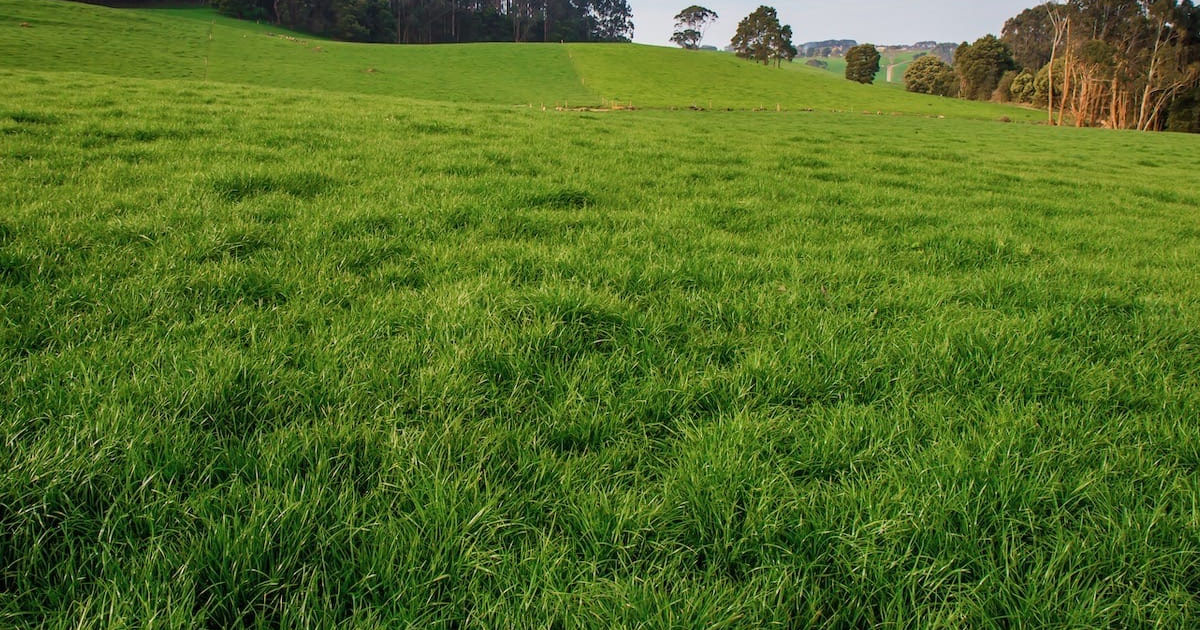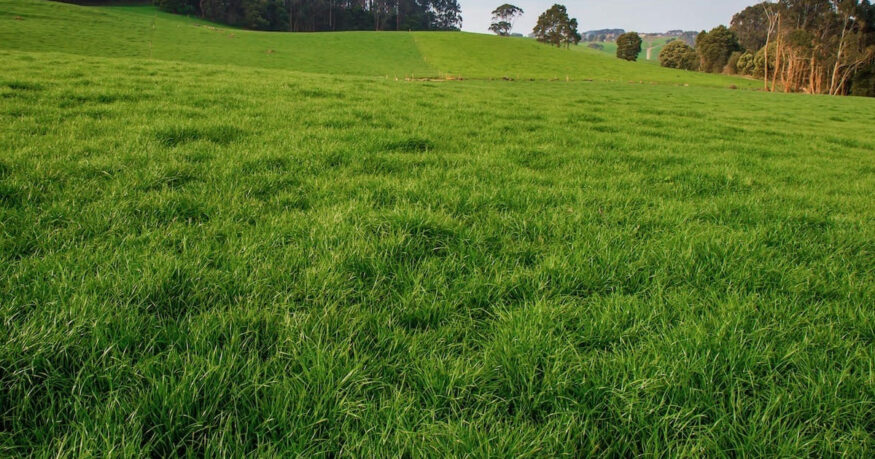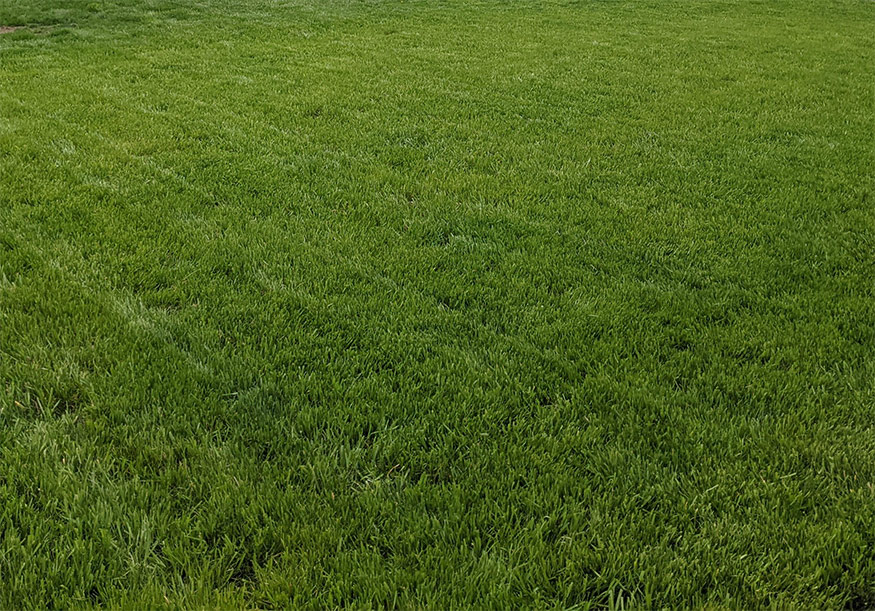Annual ryegrass is rarely used as a turfgrass except to overseed warm-season lawns for winter color. In this respect, it can be very useful for homeowners. But careful application and maintenance are required for optimal results and to ensure the permanent grass is not damaged.
In this guide, we’ll look at important annual ryegrass characteristics to determine if it’s right for your yard. We’ll also tell you everything you need to know to care for this special-use grass using our easy-to-follow annual ryegrass care calendar.
Annual Ryegrass Overview
| Also Known As | Italian Ryegrass, Australian Ryegrass; Festuca perennis |
| Type of Grass | Cool season annual |
| Optimal Zones | Winter overseeding in southern zones |
| Root Structure | Moderate to Deep |
| Winter hardiness | Good |
| Heat Tolerance | Poor |
| Shade tolerance | Good |
| Water Requirements | High |
| Drought Tolerance | Poor |
| Self Repair Capacity | Moderate |
| Overall Maintenance Requirements | Moderate |
History
Annual ryegrass originated in Southern Europe, hence the common name, “Italian ryegrass.” It was traditionally used as fodder for livestock and continues to play this role in many regions today.
Because annual ryegrass germinates and establishes quickly, it has many advantages over perennial species for certain uses. These features combined with its deep root system make it a great choice for controlling erosion. It is also often used as a cover crop for bare land during the winter months.
For home lawns, annual ryegrass is used almost exclusively for overseeding warm-season grass in the winter. In the southern US, it is often seeded over bermudagrass to give lawns green color in colder months.
Due to its low heat tolerance and annual growing cycle, annual ryegrass dies off in the spring, allowing the permanent grass to take back over.
Annual ryegrass is not as lush, green, or soft as perennial ryegrass. But it is much less expensive and therefore persists as an affordable overseeding option.
Annual Ryegrass Characteristics
Annual ryegrass has a lot of unique characteristics that make it different from more common turfgrass species. It requires a fair amount of maintenance and only grows for a brief part of the year and only in certain climates.
To help you decide if annual ryegrass is right for your home, let’s take a closer look at the characteristics of this grass.
Type of Grass
Annual ryegrass is an annual cool-season grass. “Annual” meaning it dies back every spring. And “cool season” meaning it does most of its growing when temperatures are below 75 degrees.
In cold climates, annual ryegrass grows in the spring and fall. But in warm climates, where it is used most often, it grows only in the winter.
Optimal Zones
As an overseeding option, annual ryegrass is best suited for southern regions. To get the desired green color throughout the winter, these cold months must be mild. And to prevent persistent growth throughout the year, the weather must be warm enough in the spring to kill off the grass as permanent grass grows in.
Root Structure
Annual ryegrass has deep roots that can reach up to 6 feet in length with extended growth. This characteristic makes this species very useful as an erosion control method for freshly exposed earth. When restricted to winter growth only, roots do not develop as deeply.
This grass has a bunching growth habit and does not “creep.” Rather, spreading is achieved by seed distribution.
Cold and Heat Hardiness
In harsh climates, annual ryegrass tends to die out in both the winter and summer, taking on a biannual growth habit. In warm climates, it will grow only in the winter.
Shade Tolerance
Annual ryegrass grows well in the sun and shade. Often, ryegrass will persist in shady areas of the lawn long after most of the grass has died off in the spring. This can be problematic when trying to reestablish your permanent lawn after winter.
Water Requirements & Drought Tolerance
Despite its deep roots, annual ryegrass still requires a good amount of water to thrive. Typically, it will need about 1 ¼ inch of rainfall or irrigation per week.
To maintain a green lawn throughout the winter, supplemental watering may be needed, depending on the climate.
Self Repair Capacity
Annual ryegrass has a moderate wear tolerance compared to other cool-season grasses. However, it has limited self-repair abilities. It is a bunching grass that does not form rhizomes or stolons. If an area is worn down to the dirt, reseeding will be necessary.
Annual Ryegrass Lawn Care Calendar
The annual ryegrass care calendar looks a little different than our traditional lawn care calendar.
Because this type of grass is typically only used as a winter overseeding grass, propagation begins in fall, maintenance peaks in winter, and care needs end in spring.
Fall
Annual ryegrass is a great option for adding winter color to your warm-season lawn. For best results, though, you’ll need to carefully prepare your lawn in the fall and put the seed down at the right time.
Before You Begin
The best warm-season grass to overseed with ryegrass is bermudagrass. This species tolerates the preparation needed for overseeding the best and bounces back the quickest in the spring.
It is also possible to put ryegrass seed over zoysia grass, but preparation here is much more difficult due to zoysia’s growing habits. You can learn more about the best grasses for overseeding and how to do it, here.
Aerating and Dethatching
Before you spread seed, you need to aerate your lawn to remedy compact soil. Aerated soil is better able to accept nutrients and water, which will help your annual ryegrass seed establish more quickly.
Complete core aeration at least 30 days before you intend to spread seed.
Fall is also the best time of year to dethatch your lawn. Not only will this increase the health of your bermudagrass, but it will help increase ryegrass seed germination. Use a verticutter to dethatch the lawn just prior to spreading seed in mid to late fall.
Finding the Best Time
Successful winter overseeding is all about timing. Wait to spread seed until your primary grass growth has slowed or stopped completely. But do not wait too long or else the ryegrass won’t have a chance to establish before temperatures drop.
In most climates, overseeding should take place in early to late October. Shoot for 30 days before the first expected frost when daytime temperatures are in the 70s and nighttime temperatures are in the 50s.
Preparing Your Grass
Preparing your grass to accept overseeding requires some work but is vital for success.
To prepare your existing lawn for overseeding with ryegrass, follow these steps:
- Mow your grass as short as it will tolerate. For bermudagrass, this is generally about 1 inch.
- Collect and bag all lawn clippings. In order for your seed to germinate, it needs to reach the soil. By bagging and collecting all clippings and dead grass, you’ll help ensure this happens.
- Loosen the turf with a metal rake. This is another important step in helping grass seed reach the soil and get the water and nutrients it needs to establish.
- Add a loose layer of soil. Once your grass is prepped, add a thin layer of soil over the top of it.
For more detailed information on how to complete these four steps, take a look at this article.
Spreading Seed
Using a broadcast spreader, spread annual ryegrass seed at a rate of 5 pounds per 1,000 square feet. We recommend spreading half the seed evenly over the area before turning around and spreading the rest going the opposite direction. This will help spread seeds evenly between the existing grass.
Watering
Once the seed is down, begin watering lightly multiple times per day to keep the soil moist at all times. Avoid overwatering to the point that water pools on the ground. This could wash your seed away.
Once the seed germinates, slowly reduce watering to once per day. As the grass continues to grow, decrease watering to once every three days.
Winter
Your annual ryegrass will establish quickly. By late fall or early winter, it should already be about 2 inches high. At this point, you can begin a normal maintenance routine.
Mowing
Begin mowing your ryegrass once it reaches about 2 inches in height. Cut to a length of 1 or 1 ½ inches with a sharp rotary blade or reel mower.
Mow as needed to avoid taking more than ⅓ of the blade length off at a time. For well-fertilized lawns, this may be up to once per week throughout the winter.
Fertilization
Complete your first round of fertilizer after your second mowing.
Apply ½ pound of nitrogen per 1,000 square feet using a balanced fertilizer. We suggest 16-4-8 or 15-0-15 depending on the nutrient needs of your soil.
You can apply a second round of fertilizer in mid-winter at this same rate. A second round will improve color and increase growth. But be careful not to over-fertilize as this can increase the risk of certain diseases.
Watering
Annual ryegrass requires 1 ¼ inch of water per week. During dry winters, you may need to supplement natural precipitation with irrigation. Do not water until your lawn shows signs of moisture stress. The grass will wilt, turn bluish, and not bounce back as well when water is needed.
Water deeply and in the early morning for best results. Watering early in the day reduces water loss while restricting how long foliage stays wet to avoid fungus problems.
Weed Control
The most effective form of weed control for annual ryegrass lawns is even and adequate seed dispersion. If this is accomplished, grass will grow in thick and allow less space for weeds to invade.
Many winter weed herbicides target annual ryegrass. Check labels carefully to ensure all products are safe for use on this species. Use appropriate spot treatments or hand-pull weeds as needed.
Pest and Disease Control
Pythium blight disease is the most common issue for annual ryegrass in most areas. This fungus is most prevalent on lawns that are being over-watered and over-fertilized. Be sure to only water your ryegrass when it shows signs of moisture stress and limit fertilization to once or twice per winter.
Areas heavily affected should be removed and reseeded with fresh soil.
Insects are not generally a problem for winter-grown ryegrass.
Spring
As temperatures warm up in spring, annual ryegrass will begin to die. But you will still need to provide careful lawn maintenance to assure your primary grass comes back lush and green.
Fertilization
Your final winter fertilization should take place no later than late January. Spring fertilization for your primary grass should be delayed until after the ryegrass has died off and the bermuda grass begins to green up. This will help assure the ryegrass does not continue to grow throughout the spring.
Mowing
As temperatures begin to warm in early to mid-spring, set your mower height to 1 inch. A lower mowing height will stress your ryegrass and help it die off. Just be sure not to scalp your permanent lawn in the process.
Mow frequently enough to keep ryegrass short. Once this grass begins to die off and your permanent grass starts to grow in, set your mower higher. A height of 1 ½ inches is optimal for bermuda grass growth this time of year.
Watering
In hot climates, getting ryegrass to die off in the spring should not be difficult. But if you experience a cool spring or have a shady yard, you may have to do more to get your lawn to turn over.
One effective way to do this is to restrict water in the early spring. Dry conditions will help kill off ryegrass. Just be sure to increase irrigation as needed to support bermuda grass growth in mid to late spring.
Primary Grass Maintenance
Annual ryegrass should die off completely by summer. But any seeds that were allowed to spread or that didn’t germinate last fall, will likely germinate the following fall. For this reason, it is recommended to always overseed with ryegrass once you’ve done it once.
If you do not overseed again the following autumn, you’re likely to experience unwanted patchy ryegrass growth in your otherwise dormant winter lawn.
Through the rest of spring and into summer, follow our bermuda grass maintenance calendar to keep your yard looking great all year long.


